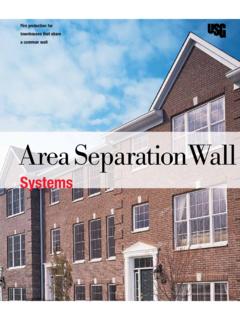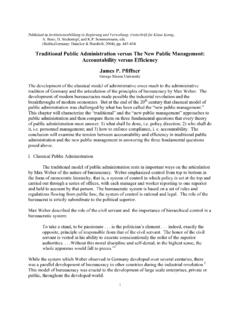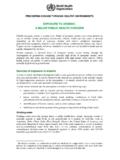Transcription of Chapter 12 Separation of Powers
1 Chapter 12 Separation of PowersSebastian Seedorf & Sanele and Conceptual Framework of the Separation of Powers Doctrine(a)'Power arrests power : the historical development of the idea of separated Powers (b)Constitutionalism, 'checks and balances and the 'pure form of Separation of Powers (c)The different forms of Separation of of Powers under the South African Constitution(a) Separation of Powers in the Interim Constitution and the ConstitutionalPrinciples(b) Separation of Powers in the Final Constitution(i)The legislature and the executive(ii)The judiciary(iii)Independent constitutional institutions(c)Beyond the text: Separation of Powers as a living doctrine(i)A distinctively South African model of Separation of Powers (ii)Justiciability of the Separation of Powers principle(d)Emerging general principles and doctrines of Separation of Powers (i)Legislature, executive and judiciary between pre-eminent domains and checks and balances(aa)A pre-eminent domain for each branch of government(bb)The availability of checks and balances(ii)Judicial review and the Separation of Powers (aa)Judicial review in the context of the supremacy of the Constitution, the political question doctrine and intergovernmental respect and courtesy(bb) Separation of Powers and the applicable standard of review(cc) Separation of Powers and remedies(iii)
2 Delegation of legislative authority and subordinate legislation(iv)Executive-controlled dispute resolutionOS 06-08, IntroductionThe adoption of the Interim1 and subsequently the Final Constitution2 is often lauded as the major milestone in the attainment of freedom in South Africa. As important a milestone as the adoption of these two Constitutions was, however, it is arguably thegovernmental structures that these Constitutions established that have been most vital in ensuring that South Africa continues to develop as a constitutional state, i e astate in which political power is restricted in various ways and in which the Constitution serves as the standard for the legitimate exercise of public restrictions on public power may be both procedural and substantive.
3 The focus of substantive restrictions is an entrenched and justiciable billof rights and a commitment to certain foundational values, such as the rule of law. The Separation of Powers falls on the procedural side, although its purpose is relatedto substantive interests: it is a means to ensure the protection of individual rights by way of the distribution of political power between different institutional actors, and includes mechanisms to ensure that such power is not unduly exercised. The idea behind Separation of Powers is that a concentration of power will most likely lead to self-interested action and abuse of power for personal gain. Historical experience suggests that benign dictators, who rule wisely, judge fairly and generally advance everyone's welfare, are very hard to find if such people ever existed.
4 The underlying idea beneath any Separation of Powers doctrine is thus the sceptical assessment that good governance is more likely when political power is distributed between different institutions and of Powers is the basis for an institutional, procedural and structural division of public power to create conditions that place human rights at the centre ofsociety. Both from an institutional and structural point of view, such a constitutional principle is an essential aspect of promoting and securing the entrenchment of South Africa's nascent constitutional democracy. Separation of Powers as well as democracy and the rule of law are therefore linked to the constitutional project of creating a society founded on the recognition of human rights, peaceful co-existenceand development opportunities for all South Africans.
5 The objective of Separation of Powers is to curtail the exercise of political power to prevent its abuse meaning the violation of human rights. This instrumental function of Separation of Powers as an institutional mechanism to protect human rights is the reason why the combination of these two ideas ( Separation of Powers and human rights) has been called the 'core of constitutionalism'.3 And it is these features that have ensured thatthere really has been a decisive break from the past constitutional system in South 06-08, ch12-p2 Separation of Powers means that specific functions, duties and responsibilities areallocated to distinctive institutions with defined areas of competence and 1 Constitution of the Republic of South Africa Act 200 of 1993 ('Interim Constitution' or 'IC').
6 2 Constitution of the Republic of South Africa, 1996 ('Final Constitution' or 'FC').3 Jan-Erik Lane Constitutions and Political Theory (1996) 25. See also Iain Currie & Johan de Waal The Bill of Rights Handbook (5th Edition, 2005) Separation of public Powers is, in short, Separation of public institutions (legislature, executive and judiciary) and of public functions, i e the making of law, law application and execution, and dispute resolution. Functional distribution leads to specialization and this, in turn, enhances state efficiency the second rationale for Separation of Powers . In US constitutional law, the argument that a proper division of public functions and their attribution to particular institutions helps government to perform better was employed to justify a strong executive with a powerful President at its More generally, the underlying idea is that particular institutions are particularly well equipped to perform a particular function.
7 In complex modern societies with numerous stakeholders and multifaceted decision-making processes, this argument takes account of the level of specialization and expertise required for the delivery of 'good governance'. When only people who know what they are talking about are involved in the decision-making process it is more likely that the outcome will be just and equitable and serve the public good. This argument thus relates to the first rationale of Separation of Powers , i e prevention of the abuse of power. On the other hand, the efficiency rationale has lostsome of its force due to the fact that pure efficiency has to be limited to some degree to ensure that all relevant considerations in the decision-making process are taken into account. Unhindered technocratic rule by experts (not questioning their knowledge of the subject at all) may lead to institutional deafness and ignorance of the plight of others and, in the worst case, to exactly the kind of human rights violations and abuses of power the Constitution aims to prevent.
8 The prevailing purpose of checks and balances as part of the Separation of Powers doctrine is therefore to ensure that institutions do not become too self-centred in their conduct, even if they are thus impeded in efficiently fulfilling their functions to a certain Chapter engages in a detailed analysis of the import and impact of the doctrine of Separation of Powers in the development of South Africa's constitutional law. Before moving to consider exactly how the doctrine has manifested itself in the South African context, the first part of the Chapter will briefly consider the doctrine's origins and its profound influence on the development of the modern democratic state premised on the idea of limited government. This analysis will seek to show that the doctrine's success as a means of establishing a fairly predictable set of structured constitutional arrangements has resulted in a growing tendency to emphasize the doctrine's form over its the second part of the Chapter the focus will turn to a consideration of how the doctrine has been incorporated in the text of the Final Constitution, in spite of the fact that the constitutional text makes no reference direct or indirect to Separation of Powers .
9 In this section it will be shown that, rather than slavishlyOS 06-08, ch12-p3following other states' interpretation of the doctrine, the drafters of the Final Constitution incorporated the idea of Separation of Powers in a manner that was 'distinctively' conceived to meet South Africa's peculiar needs and context. Further, this section will commence with the consideration of the Constitutional Court's jurisprudence on Separation of Powers . This analysis will be prefaced by a consideration of the Court's own role with respect to the development of the Separation of Powers as a justiciable doctrine, particularly in light of its own far-reaching Powers of judicial Stone, Louis Seidman, Cass Sunstein, Mark Tushnet & Pamela Karlan Constitutional Law (5th Edition, 2005) final part of the Chapter will engage in an analysis of the Constitutional Court's Separation of Powers jurisprudence and in so doing identify some important emerging features and principles.
10 Although the development of this jurisprudence has necessarily been conducted on a case-by-case basis, a cumulative reading of theConstitutional Court's judgments illustrates that the doctrines and principles identified in this Chapter have heavily influenced the Court's goal of distilling a 'distinctively South African model of Separation of Powers '. This section further seeksto demonstrate that, although the judgments discussed go a long way towards illuminating the Separation of Powers doctrine in South Africa, the Constitutional Court's conceptualization of this doctrine is, much like South Africa's overall constitutional project, an ongoing enterprise to which there are no full and final Origins and conceptual framework of the separationof Powers doctrine(a) 'Power arrests power'.







